【手把手AI项目】七、MobileNetSSD通过Ncnn前向推理框架在PC端的使用(目标检测 objection detection)
前言
- 安装win10+linux-Ubuntu16.04的双系统(超细致)
- ubuntu16.04+caffe+CUDA10.0+cudnn7.4+opencv2.4.9.1+python2.7 (超超细致)
- Caffe_ssd安装以及利用VOC2012,VOC2007数据集测试VGG_SSD网络
- Caffe实现MobileNetSSD以及各个文件的具体解释,利用自己的数据集dataset训练MobileNetSSD建立模型
下载编译ncnn
git clone https://github.com/Tencent/ncnn.git
cd ncnn
mkdir -p build
cd build
cmake ..
make -j4
一波搞定下载和编译 查看/home/XXX/ncnn/build/tools和/home/XXX/ncnn/build/tools/caffe分别有ncnn2mem和caffe2ncnn两个可执行文件,如下图所示
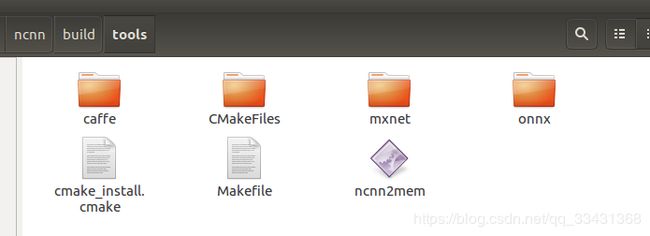

- caffe2ncnn 将caffemodel转换为ncnnmodel
- ncnn2mem 对模型进行加密操作
转换模型并加密
准备模型和网络文件
有自己数据集训练的直接用自己数据集的即可,没有的话就跟着我的来吧
这里使用上次所讲的MobileNetSSD的demo的.prototxt文件和caffemodel来使用
下载训练好的model,需要外网才可以
如何在Ubuntu16.04访问国外网站——lantern2018-07-16
deploy_model网址如下:
https://drive.google.com/file/d/0B3gersZ2cHIxRm5PMWRoTkdHdHc/view
MobileNetSSD_deploy.prototxt下载如下
https://download.csdn.net/download/qq_33431368/10850770
在/home/XXX/ncnn/build/tools/下新建一个ncnnmodel的文件夹便于管理
旧版caffe模型和网络文件转换成新版caffe模型和网络文件(ncnn只支持新版)
这个tools在caffe/build/tools中直接就有,具体操作如下
$ ~/caffe/build/tools/upgrade_net_proto_text MobileNetSSD_deploy.prototxt MobileNetSSD_deploy_new.prototxt
$ ~/caffe/build/tools/upgrade_net_proto_binary MobileNetSSD_deploy.caffemodel MobileNetSSD_deploy_new.caffemodel
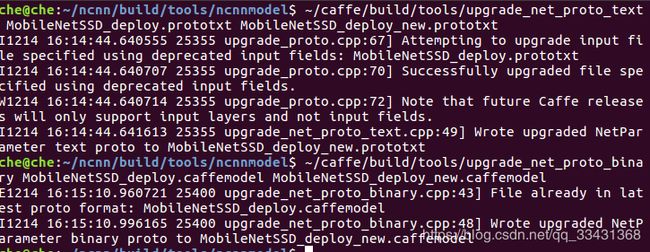 生成两个new文件
生成两个new文件

new.prototxt文件输入层改用 Input,因为每次只需要做一个图片,所以第一个 dim 设为 1
name: "MobileNet-SSD"
layer {
name: "input"
type: "Input"
top: "data"
input_param {
shape {
dim: 1
dim: 3
dim: 300
dim: 300
}
}
}
layer {
name: "conv0"
type: "Convolution"
...........
利用ncnn的两个可执行文件进行转换model和加密
利用/home/XXX/ncnn/build/tools和/home/XXX/ncnn/build/tools/caffe分别有ncnn2mem和caffe2ncnn两个可执行文件
转换model
$./caffe2ncnn' MobileNetSSD_deploy_new.prototxt MobileNetSSD_deploy_new.caffemodel MobileNetSSD_deploy.param MobileNetSSD_deploy.bin
.param相当于prototxt网络文件,.bin相当于caffemodel模型文件
加密(去掉可见字符串, 一种常见加密方式,不加密的话自己的网络可能被别人套用)
$./ncnn2mem mobilenet.param mobilenet.bin mobilenet.id.h mobilenet.mem.h

最后文件所示
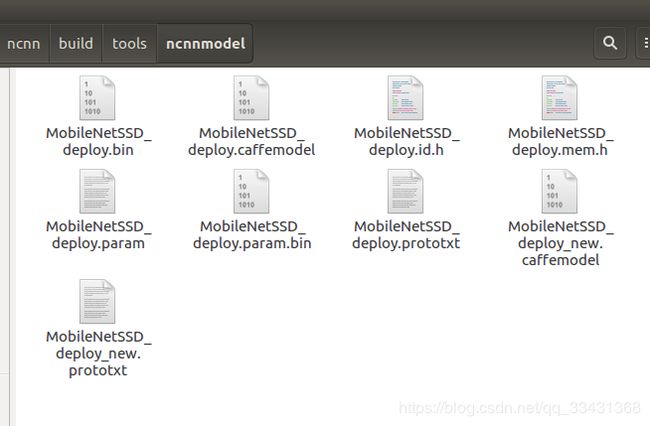
加密与不加密使用上稍微有点不同,主要体现在load_model上
//j加载非加密的ncnn模型
ncnn::Net net;
net.load_param("MobileNetSSD_deploy.param");
net.load_model("MobileNetSSD_deploy.bin");
//加载加密的ncnn模型
ncnn::Net net;
net.load_param_bin("MobileNetSSD_deploy.param.bin");
net.load_model("MobileNetSSD_deploy.bin");
在PC上run(未加密的,下面叙述的android端使用加密)
在 ncnn/examples中有 mobilenetssd.cpp 我们利用这个文件进行操作
为了不丢失这个demo,我们另外复制一个文件依然在这个文件夹中重命名为MobileNetSSD.cpp
MobileNetSSD.cpp文件修改并做出说明
#include 将这两个文件MobileNetSSD_deploy.param、MobileNetSSD_deploy.bin也复制到这个文件夹中,然后打开ncnn/examples目录下的CMakeLists.txt文件,增加这两行:
add_executable(MobileNetSSD MobileNetSSD.cpp)
target_link_libraries(MobileNetSSD ncnn ${OpenCV_LIBS})
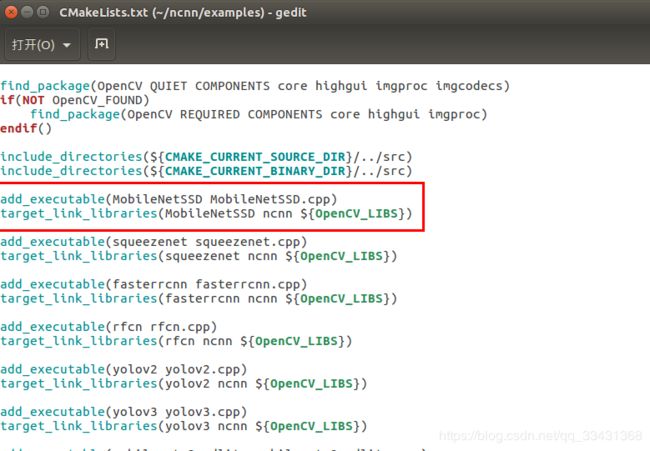
打开ncnn根目录下的CMakeLists.txt文件,将编译examples语句的注释打开(默认是被注释掉的)
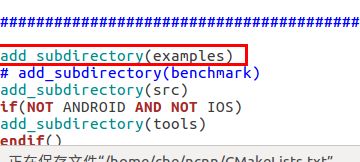
最后进入ncnn/build路径点开terminal终端
make
就发现编译的可执行文件有了,相当于走了一波.cpp文件的编译过程
 查看 ncnn/build/examples文件中
查看 ncnn/build/examples文件中
 用VOC测试图片试一下即可有效果
用VOC测试图片试一下即可有效果
测试之前需要把测试图片和ncnnmodel和网络文件都拷贝到这个文件夹中
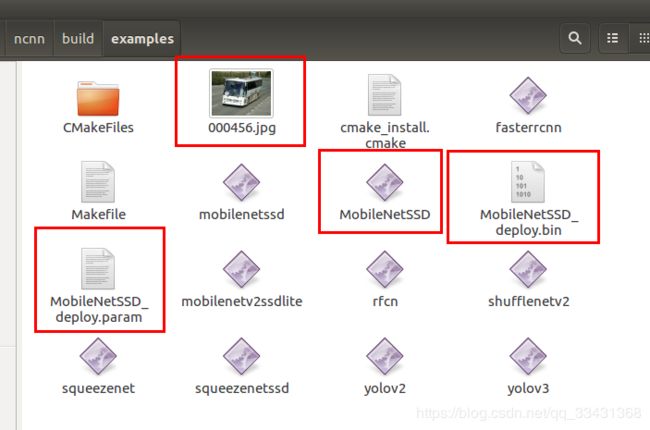
./MobileNetSSD 000456.jpg
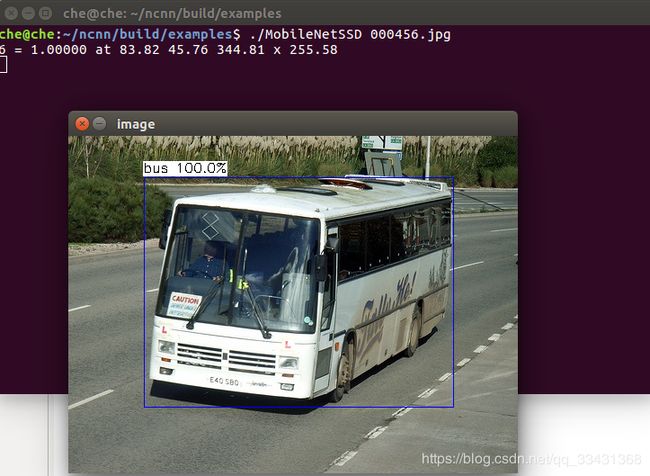
PS: 如果觉得本篇本章对您有所帮助,欢迎关注、评论、点赞!Github给个Star就更完美了_!
联系本人,手机观看,欢迎关注本人公众号
Reference
https://blog.csdn.net/computerme/article/details/77876633
https://blog.csdn.net/qq_36982160/article/details/79929869
https://github.com/Tencent/ncnn/wiki/ncnn-%E7%BB%84%E4%BB%B6%E4%BD%BF%E7%94%A8%E6%8C%87%E5%8C%97-alexnet
